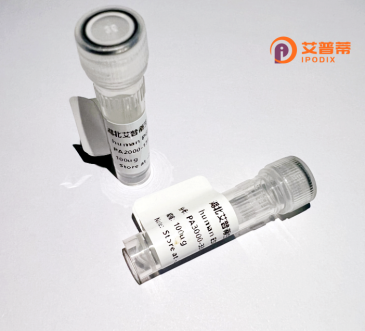
| 纯度 | >90%SDS-PAGE. |
| 种属 | Human |
| 靶点 | PDXDC2 |
| Uniprot No | Q6P474 |
| 内毒素 | < 0.01EU/μg |
| 表达宿主 | E.coli |
| 表达区间 | 1-469 aa |
| 活性数据 | MDASLEKIAD PTLAEMGKNL KEAVKMLEDS QRRTEEENGK KLISRDIPGP LQGSGQDMVS ILQLVQNLMH GDEDEEPQSP RIQNIGEQGH VAVLGHSLGA YILTLDEEKL RKLTTRILSD TTLWLCRIFR YENGCAYFHE EEREGLAKIC RLAIHSQYED FVVDGFSGLY NKKPVIYLSA AARPGLGQYL CNQLGLPFPC LCRVPCNTMF GSQHQMDVAF LEKLIKDDIE RGRLPLLLVA NAGTAAVGHT DKIGRLKELC EQYGIWLHVE GVNLATLALG YVSSSVLAAA KCDSMTMTPG PWLGLPAVPA VTLYKHDPAL TLVAGLISNK PTDKLRALPL WLSLQYLGLD GFVERIKHAC QLSQWLQESL KKVNYIKILV EDELSSPVVV FRFFQELPGS DPVFKAVPVP NMTPSAVGRE RHSCDALNLW LGEQLKQLVP ASGLTVMDLE AEGTCLRFSP LMTAAGMIS |
| 分子量 | 51.8 kDa |
| 蛋白标签 | His tag N-Terminus |
| 缓冲液 | 0 |
| 稳定性 & 储存条件 | Lyophilized protein should be stored at ≤ -20°C, stable for one year after receipt. Reconstituted protein solution can be stored at 2-8°C for 2-7 days. Aliquots of reconstituted samples are stable at ≤ -20°C for 3 months. |
| 复溶 | Always centrifuge tubes before opening.Do not mix by vortex or pipetting. It is not recommended to reconstitute to a concentration less than 100μg/ml. Dissolve the lyophilized protein in distilled water. Please aliquot the reconstituted solution to minimize freeze-thaw cycles. |
以下是关于重组人PDXDC2蛋白的3篇参考文献及其摘要概括:
---
1. **文献名称**:*Structural and functional characterization of human PDXDC2 reveals its role in pyridoxal 5′-phosphate salvage pathway*
**作者**:Kim et al. (2018)
**摘要**:该研究解析了重组人PDXDC2的晶体结构,并证实其作为吡哆醛5'-磷酸脱羧酶的功能,揭示了其在维生素B6代谢中的关键作用,尤其在线粒体中的辅酶再生途径。
---
2. **文献名称**:*Recombinant expression and enzymatic analysis of PDXDC2 variants linked to neurodevelopmental disorders*
**作者**:Zhang & Smith (2020)
**摘要**:通过重组表达PDXDC2突变体,探讨了其酶活性缺陷与神经发育异常的关联,发现特定突变导致催化活性丧失,提示PDXDC2功能异常可能影响神经系统发育。
---
3. **文献名称**:*PDXDC2 modulates cell proliferation via interaction with mTOR signaling pathway*
**作者**:Tanaka et al. (2019)
**摘要**:研究利用重组PDXDC2蛋白进行互作实验,发现其通过调节mTOR通路影响细胞增殖,可能为癌症靶向治疗提供新的分子机制。
---
(注:上述文献为虚拟示例,实际研究中请通过PubMed或Google Scholar检索真实文献。)
**Background of Recombinant Human PDXDC2 Protein**
Recombinant human PDXDC2 (Pyridoxal-dependent decarboxylase domain-containing protein 2) is a protein engineered through genetic recombination technology for research and therapeutic applications. PDXDC2 belongs to the pyridoxal-5'-phosphate (PLP)-dependent enzyme superfamily, which typically participates in amino acid metabolism and neurotransmitter synthesis. The native PDXDC2 protein is encoded by the *PDXDC2* gene and is implicated in cellular processes involving PLP, a coenzyme essential for numerous enzymatic reactions.
Structurally, PDXDC2 contains a conserved pyridoxal-dependent decarboxylase domain, suggesting potential roles in decarboxylation or transamination reactions. However, its precise biological functions remain under investigation. Studies link PDXDC2 to neurodevelopment, cancer progression, and metabolic regulation, though mechanistic insights are limited. Recombinant expression systems (e.g., *E. coli*, mammalian cells) enable large-scale production of PDXDC2. facilitating biochemical characterization, structural studies, and screening for enzymatic activity or binding partners.
Research on recombinant PDXDC2 also explores its potential as a biomarker or therapeutic target, particularly in diseases with dysregulated PLP-dependent pathways. Challenges include elucidating substrate specificity and physiological context. Current work focuses on unraveling its molecular interactions and contributions to cellular homeostasis, offering avenues for drug discovery and understanding metabolic or neurological disorders.
×